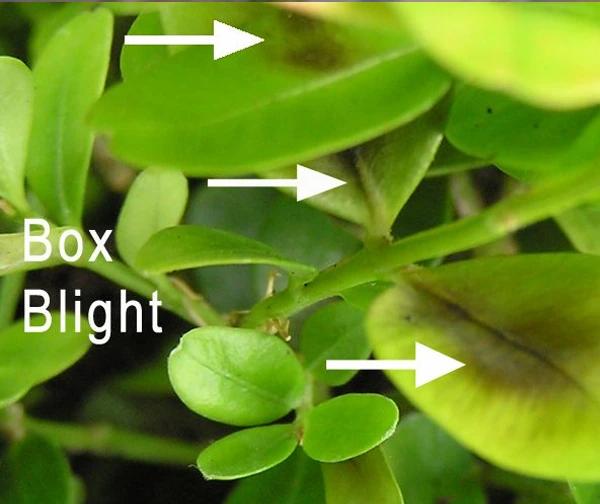Box Blight Fungi 
Box Blight refers to two separate fungi that attack Common Box and Dwarf Box.
It does not affect Box-Leaf Holly, nor Sweet Box.
The two fungi can be present together.
Cylindrocladium buxicola is relatively new in the UK. It causes dead spots on leaves, and eventually full defoliation, killing the plant.
It can be identified by the wispy grey-white fungus on the underside of the leaves (these are less visible in dry weather, so put a sample of the leave in a zip-lock back with a few drops of rainwater to check after a few days), and black streaky staining on the woody parts of the plant. The first research paper on Cylindrocladium buxicloa was only published in 2000, and it is currently being studied at Wisley and elsewhere.
Volutella buxi is the UK's "traditional" box blight fungus, and although much less serious it still ruins the appearance.
An infected plant develops pink-ish pustules on the underside of the leaves. As above, these are most likely to develop in humid weather.
The leaves yellow and fall off the plant, and in severe cases cankers can develop on the branches and trunk.
Both fungi are believed to lie dormant on dead leaves on the ground, producing spores in spring as temperatures rise. The spores are then "poofed" up into the air (that may not be the scientific term) by rain drops hitting them.
Prevention
The easiest form of control is therefore to rake up and burn or dispose of dead leaves (not in the compost). When trimming your Box, try using a groundsheet (you may find that an old decorator's cloth sheet is more convenient than a plastic or tarpaulin one in awkward areas) to collect the clippings.
After clipping and cleaning up the trimmings, mulch around your plants to cover the soil.
Good planting, in a site with good air flow and soil containing plenty of organic matter, will make your plants healthy and resistant to disease.
Top dressing with blood, fish and bone in the spring, and a precautionary spray with a fungicide such as Scotts RoseClear3 in early April will go a long way towards preventing outbreaks of box blight.
When is the Best Time to Trim Box to Avoid Blight?
The ideal time (weather forecast permitting) to clip Box hedges is between May and August.
The traditional time to clip box is mid-June (Derby Day, to be precise!). The only reason for that date is that Box has done most of its growing for the year by then, so you should not need to clip it again.
However, the Box Blights (certainly Volutella) are most active in warm, humid weather, and are likely to enter more easily into fresh wounds on the plant.
So it's best to forget tradition in this case, and clip according to the weather: the ideal time to clip Box is in dry, cool, breezy weather, with dry being the most important part.
Control
As with any fungal disease, all infected material should also be cut off and destroyed. Remember to disinfect tools afterwards.
There are no garden chemicals available specifically to deal with either blight, but copper fungicides and those containing penconazole seem to have some effect.
If you have a blight outbreak, follow the RHS Guide to managing it.
Subtitle
Lorem ipsum dolor sit amet, consectetur adipiscing elit. Ut et massa mi. Aliquam in hendrerit urna. Pellentesque sit amet sapien fringilla, mattis ligula consectetur, ultrices mauris. Maecenas vitae mattis tellus. Nullam quis imperdiet augue. Vestibulum auctor ornare leo, non suscipit magna interdum eu. Curabitur pellentesque nibh nibh, at maximus ante fermentum sit amet. Pellentesque commodo lacus at sodales sodales. Quisque sagittis orci ut diam condimentum, vel euismod erat placerat.
Lorem ipsum
Lorem ipsum dolor sit amet, consectetur adipiscing elit. Ut et massa mi. Aliquam in hendrerit urna.
Pellentesque sit amet sapien fringilla, mattis ligula consectetur, ultrices mauris. Maecenas vitae mattis tellus.


Lorem ipsum
Lorem ipsum dolor sit amet, consectetur adipiscing elit. Ut et massa mi. Aliquam in hendrerit urna.
Pellentesque sit amet sapien fringilla, mattis ligula consectetur, ultrices mauris. Maecenas vitae mattis tellus.
Lorem ipsum
Lorem ipsum dolor sit amet, consectetur adipiscing elit. Ut et massa mi. Aliquam in hendrerit urna.
Pellentesque sit amet sapien fringilla, mattis ligula consectetur, ultrices mauris. Maecenas vitae mattis tellus.


Lorem ipsum
Lorem ipsum dolor sit amet, consectetur adipiscing elit. Ut et massa mi. Aliquam in hendrerit urna.
Pellentesque sit amet sapien fringilla, mattis ligula consectetur, ultrices mauris. Maecenas vitae mattis tellus.
Subtitle
Lorem ipsum dolor sit amet, consectetur adipiscing elit. Ut et massa mi. Aliquam in hendrerit urna. Pellentesque sit amet sapien fringilla, mattis ligula consectetur, ultrices mauris.

